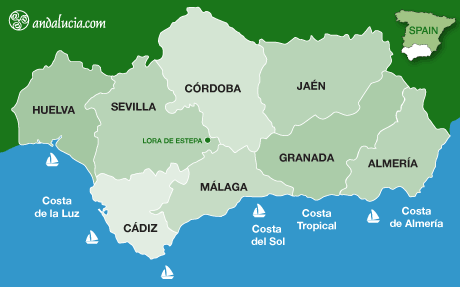LORA DE ESTEPA
by Saskia Mier
Estepa is said to produce the best extra virgin olive oil in the whole of Seville province and has received various prizes confirming this. It has about 850 inhabitants.
HISTORY
The origins of Lora de Estepa date back to the pre-Roman era, although a study of abundant Palaeolithic remains confirms the existence of settlements from the dawn of humanity. The Tartessian and Iberian cultures also left their mark in the area, as suggested by architectural structures that appeared in El Hachillo.
During the Roman era, a large town nucleus was established, "Olaura", where they built recreational villas with rich mosaics. It was only in the last few decades that the votive well, bridge, inscriptions, tombstones and mosaics of the village were uncovered. Subsequently, the Moors used an irrigation system, through ditches, to enhance the richness of planted produce, considering it to be a real orchard, and introducing, in turn, the cultivation of species such as thyme and rosemary, basic ingredients used in today's gastronomy.
THINGS TO SEE
Iglesia de San Miguel
The church was built during the eighteenth century and underwent various restorations at later dates. The images within its interior date to the seventeenth century. Located on Calle San Miguel.
Casa Cueva
We know of the existence of cave houses since the fifteenth century; during the Modern and Contemporary Age they had a prominent role, which lasted until the mid-twentieth century, as is the case of Estepa. The phenomenon of cave houses develops where there are a series of climatic and geological characteristics, together with social and historical conditions. It was the humblest families who took advantage of the rocky shelter of the slopes of the hill to adapt their houses, where they lived with livestock. Later on at the beginning of the twentieth century, they were renamed Cuevas de Orán as immigrant Estepeña families settled, having returned from the Algerian city after their African adventures failed. These caves remained inhabited until 1963, when they were evicted. Visits must be arranged beforehand at the Tourist Office, Tel. 955 91 27 17. Located on Carril de Santa María.
Cueva de La Molina
An archaeological Chalcolithic burial site of the artificial cave of La Molina, dating between the end of the fourth millennium and the first half of the third millennium ANE. Located on Avenida Principe de Asturias.
Hotels near Lora de Estepa
Book Hotels near Lora de Estepa
NATURAL AREAS
Arroyo de la Fuente de Santiago
The spring is located in the foothills of the Sierra del Becerrero and has important underground aquifers, given the limestone nature of the area and the filtration that occurs in terrains of these characteristics. The quality of the waters of the eastern limestone aquifer is of great importance in the area, given that urban demand, human consumption and crop irrigation derive from it. An ideal location for spotting local flora and flauna. Located on Camino del Arroyo de la Fuente de Santiago.
Lora de Estepa has some unique hilltops which not only provide excellent viewpoints over the area, but are also abundant with flora and fauna. These are: Cerro del Guichón, Monte Hacho, Piedra del Águila and Puntal de Peña Rubia.
GASTRONOMY
Traditional dishes to try when visiting Lora de Esrepa include guisos de carne (meat stews), pimientos (local peppers), chivo a la pastoril (stewed goat), picadillo de naranja (orange salad), salmorejo, papas en caldillo (stewed potatoes), pajaritos de la huerta (wild birds), cazuela de habas (stewed broad beans) and espárragos en salsa (asparagus in sauce). Sweet treats include hornazos y pestiños (sweet pastries) and magdalenas (muffins). One must not forget to mention the olive oil from the Cooperativa San José, which is a star ingredient.
FESTIVALS
Cabalgata Reyes Magos
Three Kings procession celebrated on the evening of 5 January.
Fiesta de la Candelaria
Celebrated on 2 Febuary.
San Blas
Celebrated on 3 Febuary.
Carnaval
Celebrated in February.
Semana Santa
Holy Week.
Romería de San Marcos
Celebrated the first week of May.
Feria de San Miguel
Celebrated on 29 September.
NEIGHBOURING VILLAGES
The nearby villages to Lora de Estepa are Estepa, Pedrera and La Roda de Andalucía.
